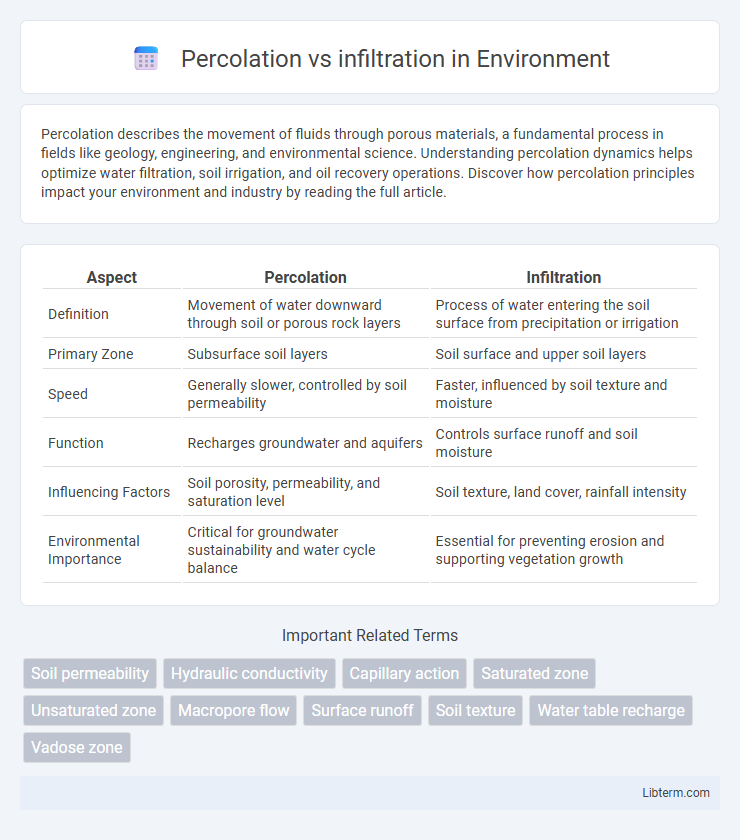Percolation describes the movement of fluids through porous materials, a fundamental process in fields like geology, engineering, and environmental science. Understanding percolation dynamics helps optimize water filtration, soil irrigation, and oil recovery operations. Discover how percolation principles impact your environment and industry by reading the full article.
Table of Comparison
| Aspect | Percolation | Infiltration |
|---|---|---|
| Definition | Movement of water downward through soil or porous rock layers | Process of water entering the soil surface from precipitation or irrigation |
| Primary Zone | Subsurface soil layers | Soil surface and upper soil layers |
| Speed | Generally slower, controlled by soil permeability | Faster, influenced by soil texture and moisture |
| Function | Recharges groundwater and aquifers | Controls surface runoff and soil moisture |
| Influencing Factors | Soil porosity, permeability, and saturation level | Soil texture, land cover, rainfall intensity |
| Environmental Importance | Critical for groundwater sustainability and water cycle balance | Essential for preventing erosion and supporting vegetation growth |
Introduction to Percolation and Infiltration
Percolation refers to the downward movement of water through soil layers, primarily influenced by gravity and soil permeability, and plays a crucial role in groundwater recharge. Infiltration is the process where water on the ground surface enters the soil, governed by soil texture, vegetation cover, and rainfall intensity, impacting surface runoff and soil moisture levels. Understanding the rates and mechanisms of both percolation and infiltration is essential for effective water management in agriculture and environmental conservation.
Defining Percolation: Key Concepts
Percolation refers to the movement of water through the soil profile, passing downward from the surface to deeper layers. This process is influenced by soil texture, porosity, and saturation levels, determining the rate at which water moves. Unlike infiltration, which describes water entering the soil surface, percolation emphasizes water's vertical journey through soil pores, crucial for groundwater recharge and soil moisture distribution.
Infiltration Explained: An Overview
Infiltration refers to the process by which water on the ground surface enters the soil, moving vertically through soil pores influenced by soil texture, structure, and moisture content. It plays a crucial role in recharging groundwater, controlling surface runoff, and maintaining soil moisture essential for plant growth. Unlike percolation, which involves the downward movement of water through soil layers beyond the root zone, infiltration specifically denotes the initial entry of water into the soil surface.
Differences Between Percolation and Infiltration
Percolation refers to the movement of water downward through soil layers, primarily influenced by soil permeability and gravity, while infiltration is the process of water entering the soil surface from precipitation or irrigation. Percolation often occurs after infiltration, involving deeper soil layers and groundwater recharge, whereas infiltration focuses on surface soil absorption capacity and rate. Key differences include that infiltration is limited by surface soil porosity and saturation, while percolation depends on subsurface soil structure and hydraulic conductivity.
Factors Affecting Percolation Rates
Soil texture, structure, and moisture content are key factors affecting percolation rates, with sandy soils promoting faster percolation compared to clayey soils due to larger pore spaces. Organic matter enhances soil porosity, improving water movement and percolation efficiency. Terrain slope and compaction also influence percolation by altering water runoff and infiltration capacity.
Factors Influencing Infiltration Rates
Soil texture and structure significantly influence infiltration rates, with sandy soils allowing faster water movement compared to clayey soils due to larger pore spaces. Vegetation cover enhances infiltration by reducing surface runoff and promoting soil stability, while compaction and surface crusting decrease infiltration by sealing the soil surface. Rainfall intensity and duration also affect infiltration, as heavy rain can exceed soil absorption capacity, leading to increased surface runoff and reduced infiltration.
Importance in Hydrological Cycle
Percolation and infiltration play critical roles in the hydrological cycle by facilitating groundwater recharge and maintaining soil moisture levels. Infiltration allows surface water to enter the soil, influencing runoff and erosion rates, while percolation drives the deeper movement of water through soil layers into aquifers. Effective percolation and infiltration processes ensure sustainable water availability, support vegetation growth, and regulate freshwater ecosystems.
Measurement Techniques for Percolation and Infiltration
Percolation is commonly measured using percolation tests that assess the rate at which water moves through soil layers, often utilizing standardized percolation test holes or double-ring infiltrometers. Infiltration measurement employs infiltrometers, including single-ring and tension infiltrometers, to evaluate water entry rates into the soil surface under varying conditions. Accurate assessment of both processes relies on field-based instruments and soil moisture sensors to quantify water movement dynamics essential for hydrological and agricultural applications.
Practical Applications in Environmental Science
Percolation refers to the downward movement of water through soil layers driven by gravity, crucial for groundwater recharge and contaminant transport assessment in environmental science. Infiltration involves water entering the soil surface, impacting surface runoff, erosion control, and irrigation efficiency in agricultural and watershed management practices. Understanding the differences between percolation and infiltration aids in designing effective water conservation strategies and predicting pollutant dispersion in soil and aquifers.
Conclusion: Percolation and Infiltration Compared
Percolation refers to the movement of water through soil layers to reach groundwater, while infiltration is the process of water entering the soil surface. Both processes are critical in the hydrological cycle but differ in scale and mechanism, with infiltration being the initial entry and percolation the deeper movement. Understanding their distinction aids in effective water management, soil conservation, and predicting groundwater recharge rates.
Percolation Infographic

 libterm.com
libterm.com